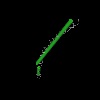?
 
Basic leucine zipper (bZIP) domain of Jun proteins and similar proteins: a DNA-binding and dimerization domain Jun is a member of the activator protein-1 (AP-1) complex, which is mainly composed of Basic leucine zipper (bZIP) dimers of the Jun and Fos families, and to a lesser extent, the activating transcription factor (ATF) and musculoaponeurotic fibrosarcoma (Maf) families. The broad combinatorial possibilities for various dimers determine binding specificity, affinity, and the spectrum of regulated genes. The AP-1 complex is implicated in many cell functions including proliferation, apoptosis, survival, migration, tumorigenesis, and morphogenesis, among others. There are three Jun proteins: c-Jun, JunB, and JunD. c-Jun is the most potent transcriptional activator of the AP-1 proteins. Both c-Jun and JunB are essential during development; deletion of either results in embryonic lethality in mice. c-Jun is essential in hepatogenesis and liver erythropoiesis, while JunB is required in vasculogenesis and angiogenesis in extraembryonic tissues. While JunD is dispensable in embryonic development, it is involved in transcription regulation of target genes that help cells to cope with environmental signals. bZIP factors act in networks of homo and heterodimers in the regulation of a diverse set of cellular processes. The bZIP structural motif contains a basic region and a leucine zipper, composed of alpha helices with leucine residues 7 amino acids apart, which stabilize dimerization with a parallel leucine zipper domain. Dimerization of leucine zippers creates a pair of the adjacent basic regions that bind DNA and undergo conformational change. Dimerization occurs in a specific and predictable manner resulting in hundreds of dimers having unique effects on transcription. |
